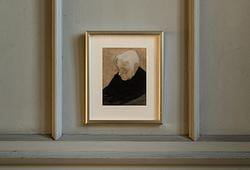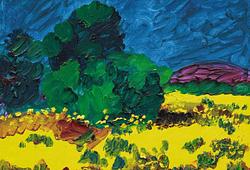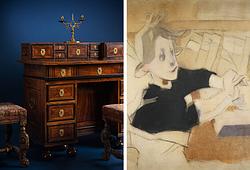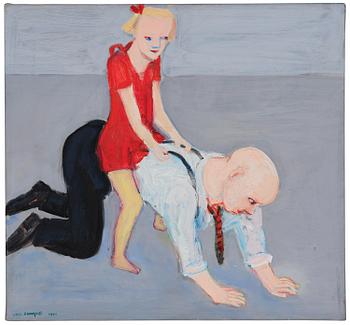Contemporary Art & Design Presents Lena Cronqvist
Bukowskis presents the work "Vilken hand?" by Lena Cronqvist at this autumn's live auction, Contemporary Art & Design – The largest live auction for contemporary art and design in the Nordics.
In a period when many artists were breaking away from traditional representation—driven above all by the American currents of Abstract Expressionism and Pop Art—Lena Cronqvist chose a different path. She remained committed to figuration and to a deeply personal subject matter, an approach she has sustained throughout her career.
Her hallmark style consists of full-length depictions of children, most often young girls, whose seemingly playful scenes conceal unsettling, sometimes grotesque undertones. In numerous works the children interact with dolls that serve as stand-ins for their parents. At times these appear in innocent, dollhouse-like role reversals that destabilize familial hierarchies; in other instances, the dolls are subjected to violent or sexually charged acts. These images confront the anxieties and struggles of growing up—concerns that later re-emerge in Cronqvist’s self-portraits as an older woman, where the tension shifts from childhood to the realities of aging. The dynamic has reversed: now it is the girls who resemble dolls, subject to her control in gestures marked by both urgency and release.

Vilken hand? (Which Hand?) revisits Cronqvist’s autobiographical reflections on childhood. The composition is stripped down, yet its atmosphere is heavy with intensity. A solitary girl stands on a beach, her face unusually pensive and tinged with sadness for her age. Her features recall photographs of Cronqvist herself as a child, and reappear throughout her work in the recurring figure of the elder sister. The painting’s title alludes to a hidden choice: the girl clasps something in each hand behind her back, offering the unseen counterpart before her only one. Could these be the parental dolls so central to Cronqvist’s imagery? Despite the presence of a cat and a dog, the child’s solitude and melancholy imbue the picture with existential gravity. It remains one of Cronqvist’s most emblematic works—at once restrained and charged, rooted in personal memory yet resonating on a universal level.
To the catalogue

The works will be sold at Contemporary Art & Design
Estimate 800 000 - 1 000 000 SEK
Online catalogue will be published on October 9
Viewing October 17–21, Berzelii Park 1, Stockholm
Live auction October 22–23, Arsenalsgatan 2, Stockholm
Read more about Contemporary Art & Design
All works by Lena Cronqvist at Contemporary Art & Design
Requests & condition reports

Stockholm
Louise Wrede
Head of Art Department, Specialist Contemporary Art, Private Sales
+46 (0)739 40 08 19

Stockholm
Andreas Rydén
Head Specialist, Art, Deputy Managing Director
+46 (0)728 58 71 39

Stockholm
Karin Aringer
Head Specialist Contemporary Art and Photographs
+46 (0)702 63 70 57





























